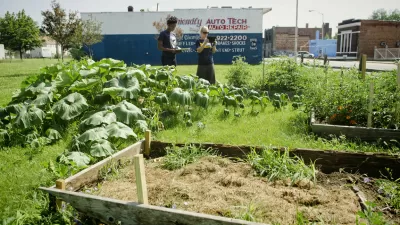This commentary from the Austin American Statesman argues that the city's aim to become the country's most livable city is undercut by its low number of community gardens.
"The laundry list of green initiatives adopted by the City of Austin is a tribute to Austin's commitment to becoming the most livable city in the country. Green oases in the middle of urban areas, community gardens are a necessary part of any livable city. Located in areas easily accessible to residents, these public spaces offer land on which neighbors work together to grow their own food, thereby reducing fuel consumption and pollution emitted by trucking produce across the country."
"Austin is home to 12 community gardens. For a city the size of Austin, this number is well below that of urban areas of similar size. In Portland, Ore., the Parks and Recreation department operates 30 community gardens with assistance from the Friends of Portland Community Gardens. Seattle's Department of Neighborhoods P-Patch Program works with the P-Patch Trust to support the efforts of 54 community gardens."
"Unlike the public programming that supports community gardening in Portland and Seattle, the process for starting a garden in Austin is cumbersome and costly. Though the city does permit groups to use public land for gardens for a nominal annual fee, only five community gardens reside on public property."
FULL STORY: Banks: What's so livable about a city without community gardens?

Alabama: Trump Terminates Settlements for Black Communities Harmed By Raw Sewage
Trump deemed the landmark civil rights agreement “illegal DEI and environmental justice policy.”

Planetizen Federal Action Tracker
A weekly monitor of how Trump’s orders and actions are impacting planners and planning in America.

Why Should We Subsidize Public Transportation?
Many public transit agencies face financial stress due to rising costs, declining fare revenue, and declining subsidies. Transit advocates must provide a strong business case for increasing public transit funding.

Understanding Road Diets
An explainer from Momentum highlights the advantages of reducing vehicle lanes in favor of more bike, transit, and pedestrian infrastructure.

New California Law Regulates Warehouse Pollution
A new law tightens building and emissions regulations for large distribution warehouses to mitigate air pollution and traffic in surrounding communities.

Phoenix Announces Opening Date for Light Rail Extension
The South Central extension will connect South Phoenix to downtown and other major hubs starting on June 7.
Urban Design for Planners 1: Software Tools
This six-course series explores essential urban design concepts using open source software and equips planners with the tools they need to participate fully in the urban design process.
Planning for Universal Design
Learn the tools for implementing Universal Design in planning regulations.
Caltrans
Smith Gee Studio
Institute for Housing and Urban Development Studies (IHS)
City of Grandview
Harvard GSD Executive Education
Toledo-Lucas County Plan Commissions
Salt Lake City
NYU Wagner Graduate School of Public Service





























